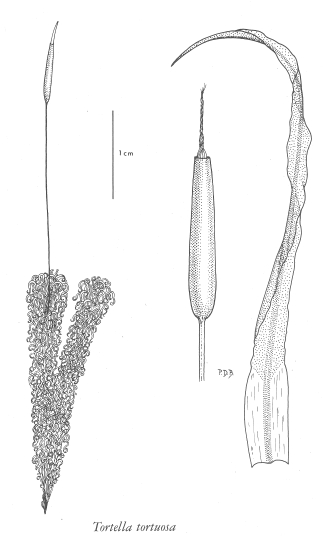Tortella tortuosa var. arctica (Hedw.) Limpr.
moss
Pottiaceae
Species Account Author: Wilf Schofield
Extracted from Some Common Mosses of BC
Introduction to the Bryophytes of BC
moss
Pottiaceae
Species Account Author: Wilf Schofield
Extracted from Some Common Mosses of BC
Introduction to the Bryophytes of BC
Map
Distribution of Tortella tortuosa var. arctica
Click here to view the full interactive map and legend
Species Information
Species description:
Genus name meaning "little twisted" in reference to the corkscrew twisted peristome teeth. Species name referring to the contorted leaves, when dry.
Reproduction:
Sporophytes occasional, maturing in spring to summer, red-brown and with markedly corkscrew twisted red-brown peristome teeth.
Distinguishing characteristics:
The pinwheel-like arrangement of the leaves at the apex of the stem (best viewed when plants are damp), the pale yellow-green leaves that have undulate margins, the remarkably contorted leaves when dry, and the frequent restriction to calcium-rich sites are useful characters. The leaf, when removed shows a clear basal area of elongate cells that form an M-shaped area as it merges with the opaque elongate point of the leaf. This characterizes the genus Tortella.
Habit:
Forming dense turfs of bright yellow-green plants in which the shoot apex is often formed of pinwheel-like radiating leaves. Leaves strongly contorted when dry.
Similar Species:
T. fragilis has rigid leaves in which the tips break off readily; T. inclinata has bluntish leaf apices; T. humilis is a small plant and the leaves lack undulating margins. Oxystegus tenuirostris is superficially similar but lacks the M-shaped area of clear basal cells; these clear cells gradually merge with the opaque cells. Geheebia gigantea usually produces reddish-brown plants in which the leaves are markedly recurved and lack the hyaline basal area. Leptodontium recurvifolium has markedly toothed recurved leaves and lacks the basal hyaline area. Ulota obtusiuscula is similar in colour and in the contorted leaves when dry but plants are epiphytic and tufted, and the sporophytes are usually present and bear a hairy calyptra. Trichostomum arcticum can resemble Tortella, especially in the pinwheel-like arrangement of the leaves at the shoot apices. In Trichostomum arcticum, however, the leaf base has a hyaline area that grades gradually into the opaque point, rather than forming an M-shaped area.
Illustration

If more than one illustration is available for a species (e.g., separate illustrations were provided for two subspecies) then links to the separate images will be provided below. Note that individual subspecies or varietal illustrations are not always available.
Illustration Source: Some Common Mosses of BC
Habitat and Range
Habitat
Cliffs and cliff crevices, especially in calcareous areas, usually somewhat shaded and humid, but also on tree trunks (especially yellow cedar) and in tundra vegetation; from near sea level to alpine elevations. Range
World DistributionCircumpolar in the Northern Hemisphere, also in southern South America; in North America southward in the east to the southern Appalachian Mountains and in the west to Utah, Nevada and California.
